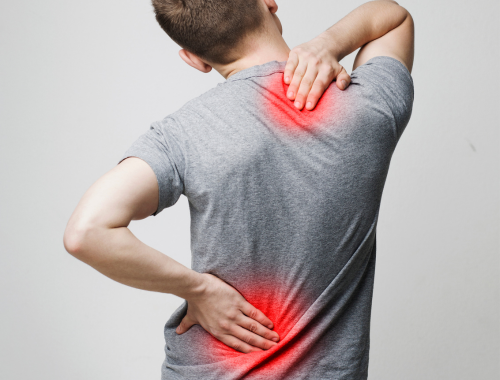Difference Between Anterolisthesis and Retrolisthesis
Anterolisthesis is a spinal disorder that manifests as anterior slippage of the vertebra in the backbone. Retrolisthesis is an uncommon spinal disorder characterized by the backward slippage of the vertebra in the backbone.

What is anterolisthesis?
Definition:
Anterolisthesis is a spinal disorder that manifests as anterior slippage of the vertebra in the backbone.
Causes:
Anterolisthesis occurs due to blunt trauma, fractures secondary to road traffic accidents or falls, or after intensive physical exercise. Aging is also linked with anterolisthesis. Vertebral tumors and arthritis can also cause anterolisthesis. or fractures.
Symptoms:
The symptoms of anterolisthesis are proportional to the degree of slippage and its location. Anterolisthesis causes severe, worsening pain over the affected area, which is mostly the lower limbs and lower back. Anterolisthesis causes partial immobility. Other symptoms include muscle rigidity, paresthesia, poor posture, loss of temperature sensations, and in severe cases paralysis and loss of bladder and bowel function.
Diagnosis:
Anterolisthesis is diagnosed via physical examination and radiologic findings on X-rays, CT scans, and MRI scan.
Treatment:
Treatment options for mild to moderate anterolisthesis include bed rest to relieve pain and further slippage, medications such as nonsteroidal anti-inflammatory drugs (NSAIDs), opioids and steroids, and physiotherapy. Surgery may be required in severe cases.

What is retrolisthesis?
Definition:
Retrolisthesis is an uncommon spinal disorder characterized by the backward slippage of the vertebra in the backbone.
Causes:
Causes of retrolisthesis include congenital disabilities, arthritis, trauma to the backbone and fractures of the backbone, spinal degenerative disorders, weak muscles adjacent to the vertebrae, osteoporosis, and osteopenia.
Symptoms:
Symptoms of retrolisthesis are sharp back pain, which may be generalized or localized to the lower back, limited range of movement, a trough or bulge in the backbone, and discomfort.
Diagnosis:
Retrolisthesis is diagnosed on lateral X-ray spine findings after history and physical examination. The lateral X-ray spine will show a slippage of more than 2mm. Additional signs which aid the diagnosis of retrolisthesis include sclerosed arteries around the vertebrae, bony spurs, compressed disc, and gas enclosed between vertebrae.
Treatment:
Treatment options for retrolisthesis include bed rest, physical therapy, strengthening exercises, medications such as nonsteroidal anti-inflammatory drugs (NSAIDs), opioids and steroids, warm compresses over the painful region, and massage. Surgery may be required in other methods fail.
Difference between Anterolisthesis and retrolisthesis
Definition:
Anterolisthesis is a spinal disorder that manifests as anterior slippage of the vertebra in the backbone. Retrolisthesis is an uncommon spinal disorder characterized by the backward slippage of the vertebra in the backbone.
Causes:
Anterolisthesis occurs due to blunt trauma, fractures secondary to road traffic accidents or falls, or after intensive physical exercise. Aging is also linked with anterolisthesis. Vertebral tumors and arthritis can also cause anterolisthesis. or fractures. Causes of retrolisthesis include congenital disabilities, arthritis, trauma to the backbone and fractures of the backbone, spinal degenerative disorders, weak muscles adjacent to the vertebrae, osteoporosis, and osteopenia.
Symptoms:
The symptoms of anterolisthesis are proportional to the degree of slippage and its location. Anterolisthesis causes severe, worsening pain over the affected area, which is mostly the lower limbs and lower back. Anterolisthesis causes partial immobility. Other symptoms include muscle rigidity, paresthesia, poor posture, loss of temperature sensations, and in severe cases paralysis and loss of bladder and bowel function. Symptoms of retrolisthesis are sharp back pain, which may be generalized or localized to the lower back, limited range of movement, a trough or bulge in the backbone, and discomfort.
Diagnosis:
Anterolisthesis is diagnosed via physical examination and radiologic findings on X-rays, CT scan, and MRI scan. Retrolisthesis is diagnosed on lateral X-ray spine findings after history and physical examination. The lateral X-ray spine will show a slippage of more than 2mm. Additional signs which aid the diagnosis of retrolisthesis include sclerosed arteries around the vertebrae, bony spurs, compressed disc, and gas enclosed between vertebrae.
Treatment:
Treatment options for mild to moderate anterolisthesis include bed rest to relieve pain and further slippage, medications such as nonsteroidal anti-inflammatory drugs (NSAIDs), opioids and steroids, and physiotherapy. Surgery may be required in severe cases. Treatment options for retrolisthesis include bed rest, physical therapy, strengthening exercises, medications such as nonsteroidal anti-inflammatory drugs (NSAIDs), opioids and steroids, warm compresses over the painful region, and massage. Surgery may be required in other methods fail.
Table of differences between Anterolisthesis and retrolisthesis

FAQs
What is the difference between retrolisthesis and Anterolisthesis XRAY?
Anterolisthesis X-ray will show anterior slippage of the vertebra in the backbone whereas retrolisthesis will show posterior slippage of the vertebrae in the backbone.
Can you have both Anterolisthesis and retrolisthesis?
Yes.
What is the other name for retrolisthesis?
Retro spondylolisthesis.
How do you treat Anterolisthesis and retrolisthesis?
Treatment options for both anterolisthesis and retrolisthesis include bed rest to relieve pain and further slippage, medications such as nonsteroidal anti-inflammatory drugs (NSAIDs), opioids and steroids, and physiotherapy. Surgery may be required in severe cases.
How serious is retrolisthesis?
It can be serious in older patients if left untreated.
When is retrolisthesis serious?
If left untreated, retrolisthesis can be serious leading to spinal cord compression.
- Difference Between Ocular Rosacea and Blepharitis - September 22, 2023
- Difference Between Toxic and Nontoxic Goiter - August 18, 2023
- Difference Between Anterolisthesis and Retrolisthesis - July 31, 2023
Search DifferenceBetween.net :
Leave a Response
References :
[0]Iguchi, Tetsuhiro, et al. "Lumbar multilevel degenerative spondylolisthesis: radiological evaluation and factors related to anterolisthesis and retrolisthesis." Clinical Spine Surgery 15.2 (2002): 93-99.
[1]Rowe, L., and I. Steiman. "Anterolisthesis in the cervical spine--spondylolysis." Journal of Manipulative and Physiological Therapeutics 10.1 (1987): 11-20.
